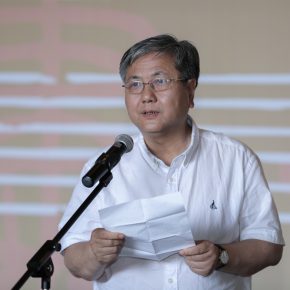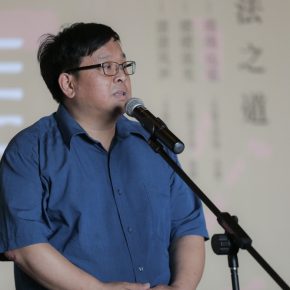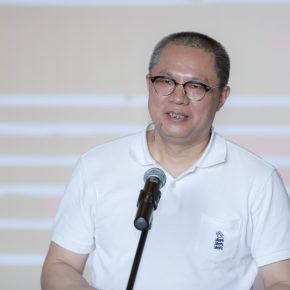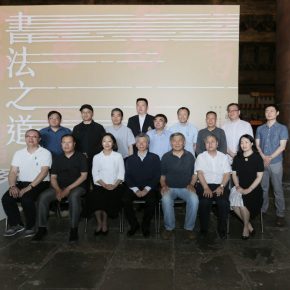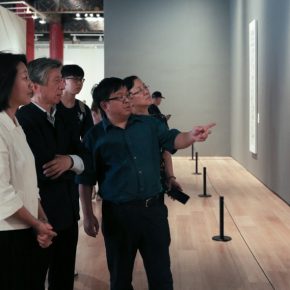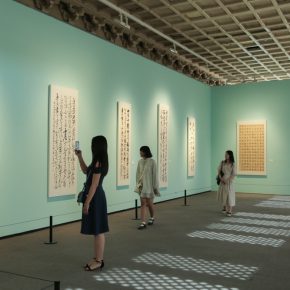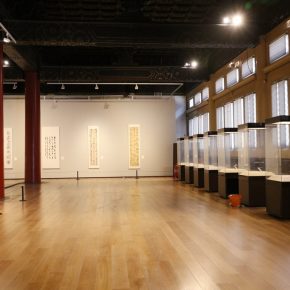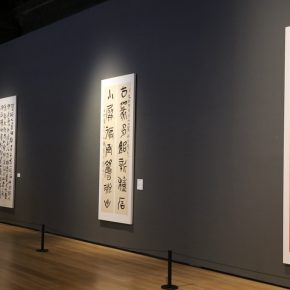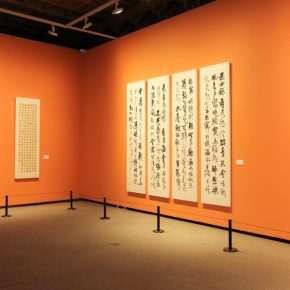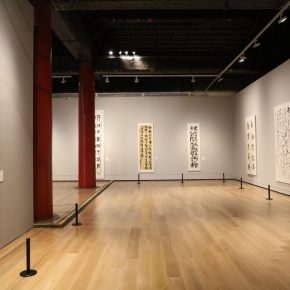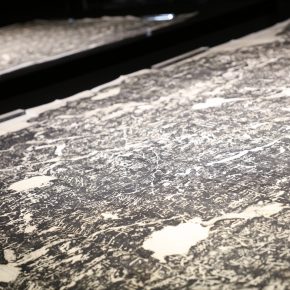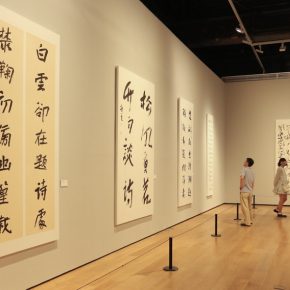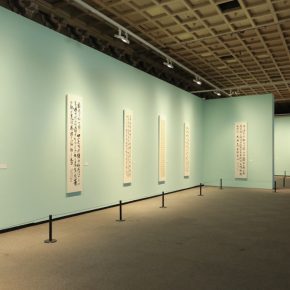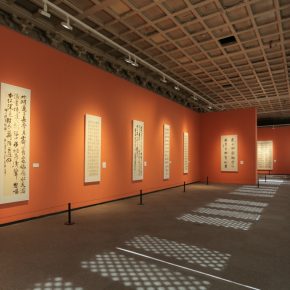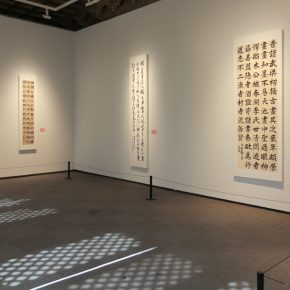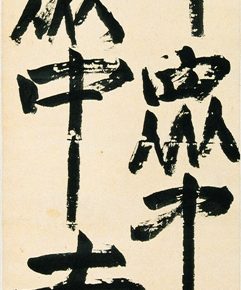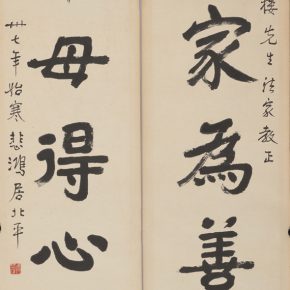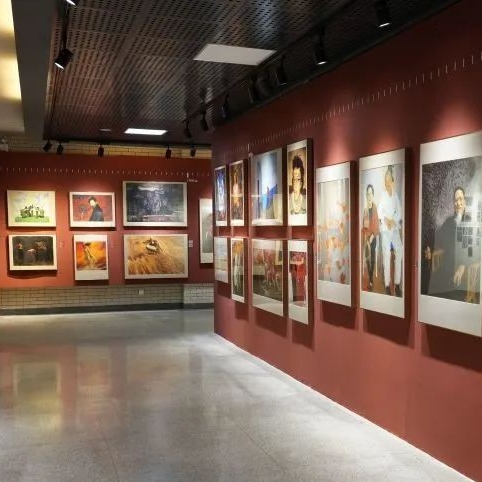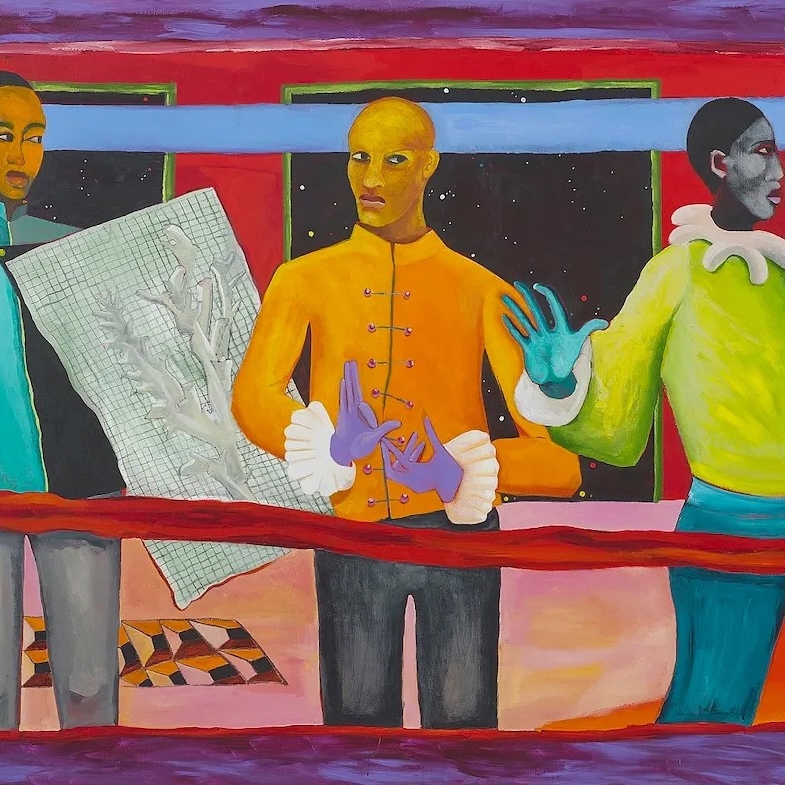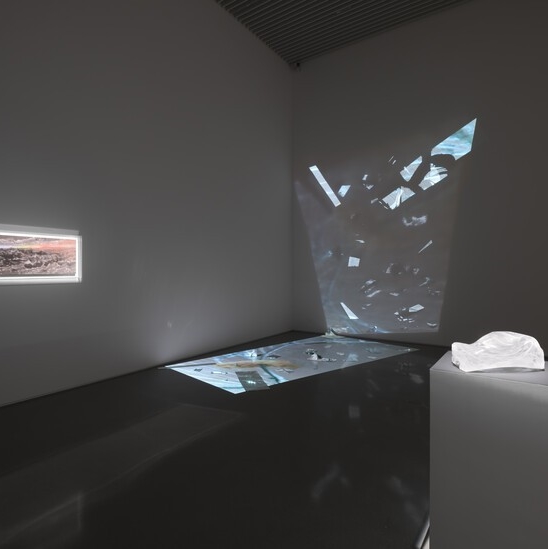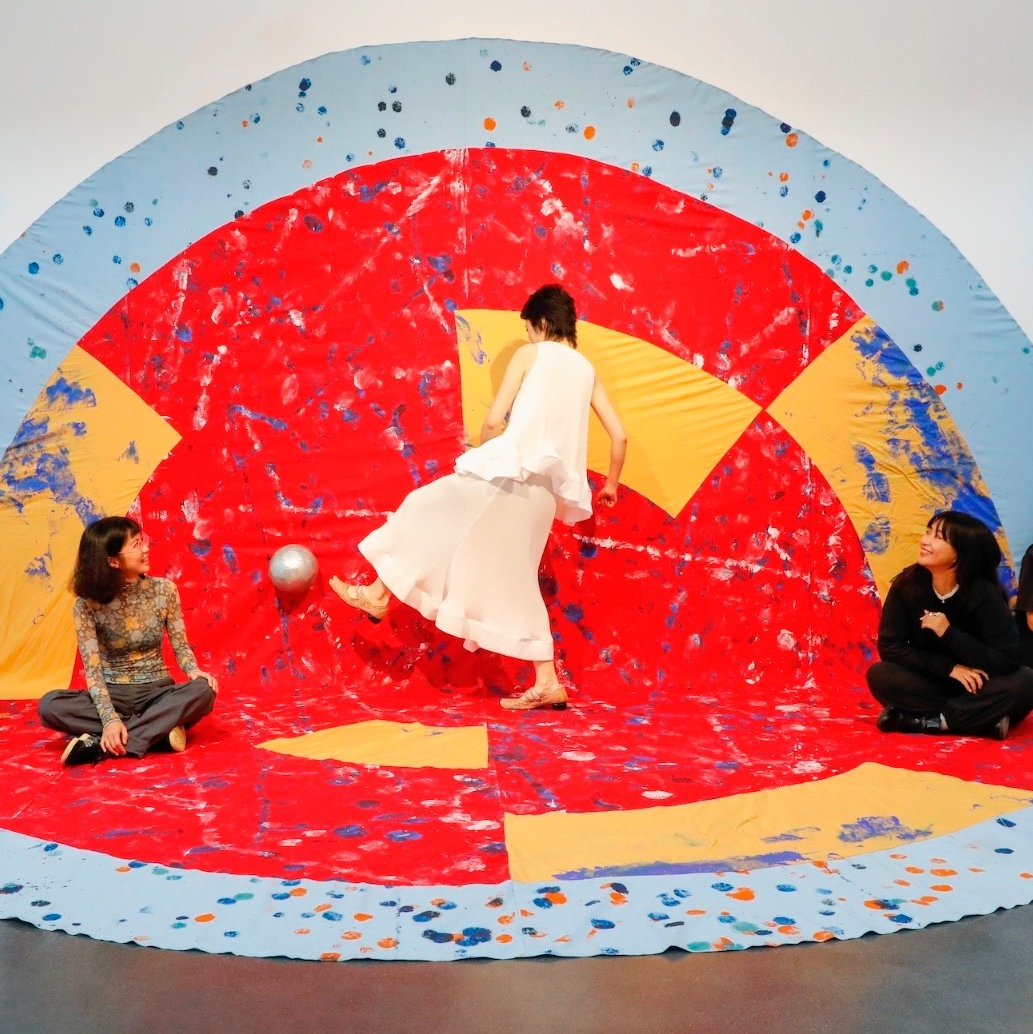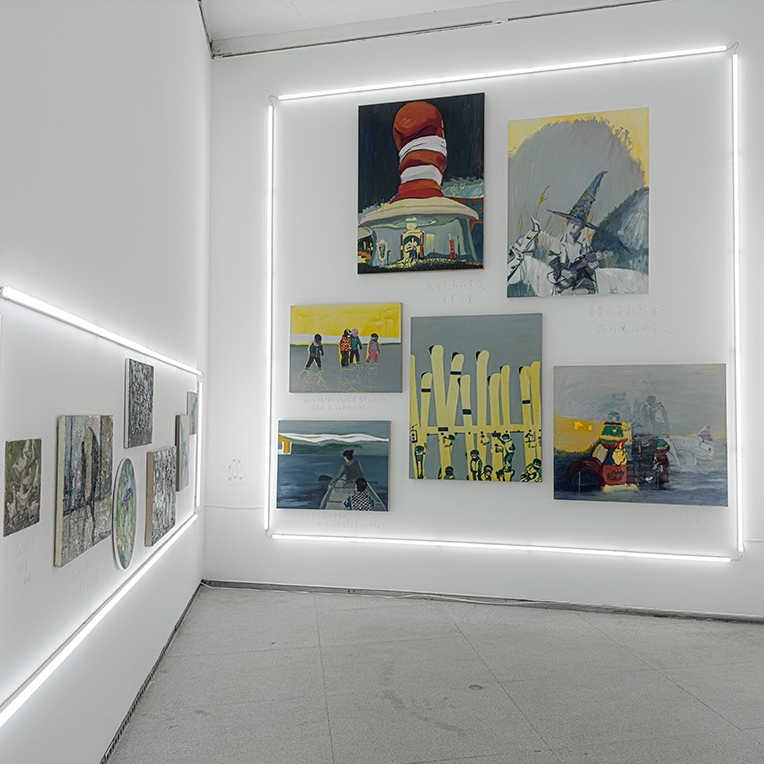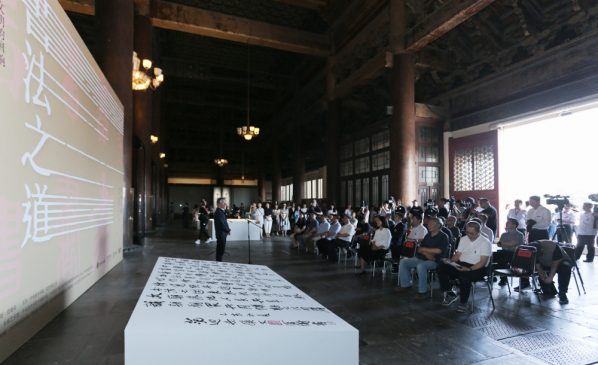
“The successive movement of the inactive and active operations constitutes what is called the course (of things). That which ensues as the result (of their movement) is goodness; that which shows it in it completeness is the nature (of men and things).” By referencing The I CHING · The Great Appendix Section I, the ‘Tao’ could be understood as the principles and rationality of one’s development. Although “Tao” and “Art” are independent from each other; however, there is a time when the two are in harmony with each other. Specifically, when one develops his or her techniques to reach a state of proficiency, then he or she might enter the realm of “Tao”. Developing “Art” to “Tao” is then reasonable.
On May 29 2019, the Exhibition “Echo of Civilization – Episode IV: The Realm of Calligraphy” debuted in the Imperial Ancestral Art Museum. The exhibition was co-organized by China Central Academy of Fine Arts and Beijing Federation of Trade Unions, and was undertaken in cooperation with Imperial Ancestral Art Museum, the School of Chinese Painting at CAFA, the Silk Road Art Research Collective Innovation Office of CAFA and the Exhibition Department of China Calligraphers Association. The exhibition is divided into three sections, namely, The Stretching Road (Mian Mian Yuan Dao, 绵绵远道), The Glistening Shine (Yi Yi Liu Guang, 熠熠流光), and The Gentle Sound of Wind (Qing Qing Feng Sheng, 清清风声). A total of 123 works of calligraphy were exhibited, including 8 works by calligraphy masters from the collection of CAFA Art Museum, 16 rubbings from the collection of CAFA Library, 3 works of calligraphy and 29 masterpieces from the collection of the Reference Room of the School of Chinese Painting at CAFA, and 67 works by outstanding graduates of CAFA. All these works outlined the development of Chinese calligraphy, showcased the exploration and innovation of contemporary Chinese calligraphy through the inheritance of the traditional and presented the developmental pattern of interlinking with “Tao” under the exquisite techniques of calligraphy.
Fan Di’an, President of China Artists Association and President of China Central Academy of Fine Arts, Zhao Lijun, Vice President and member of Beijing Federation of Trade Unions, Gu Yalong, Vice President of China Calligraphers Association, Peng Liming, the Vice President of Beijing Calligraphers Association, Wang Yong, Professor at Central Academy of Fine Arts and Ph.D. supervisor, Wang Yan, Director of Calligraphy Art Center of China Federation of Literary and Art Circles, Yan Yiduan, Vice President in residence of Guangdong Calligraphers Association, Shi Zhiyuan, Director of Exhibition Center of China Calligraphers Association, Yan Shougu, Consultant of Shandong Calligraphers Association, Tom Wang, Executive Director of Generation Fund, Xu Wen, Minister of Publicity and Education Department of Beijing Federation of Trade Unions, Li Peng, Party Secretary of Beijing Working People’s Cultural Palace, Xu Yude, Executive Vice President of Beijing Industry (National Defense) Trade Unions, Liu Qinghe, Dean of the School of Chinese Painting at CAFA, Wang Yingsheng, Dean of Research Institute of Restoration at CAFA, Yue Qianshan, Secretary of General Party Branch of the School of Chinese Painting at CAFA and representatives of artists attended the opening ceremony. Ms. Yue Jieqiong, Executive Director of the Imperial Ancestral Art Museum, Office Director of the Collective Innovation Office of CAFA, hosted the opening ceremony.
“In the 1980s, under the guidance of leaders such as Jin Shangyi and Zhu Naizheng in Central Academy of Fine Arts, conducted by Mr. Wang Yong, the research and study of Chinese calligraphy has gained large-scale achievements. A number of masters and professors have been teaching and researching here, which realized the significant academic guidance for the entire calligraphy field.” Regarding the historical construction of calligraphy as a discipline at CAFA, President Fan Di’an has pointed out in his speech in the opening ceremony that as a spiritual symbol of Chinese culture, calligraphy has gained increasing attention from all of society. The inheritance and the creating standard of calligraphy have been popularized and developed to a great extent. In this case, we need to explore the new development of Chinese calligraphy in the context of new cultural ideals and philosophy. Recently, China has involved calligraphy into the first-level discipline. Under such a background, “By holding such an exhibition for the public, it has provided society with remarkable significance and it could enhance the acknowledgement of the beauty of calligraphy in our society as a whole.”
As a unique traditional art in China, the origin and development of Calligraphy could be traced back to the use of pattern to take notes. With developments over thousands of years, Chinese characters were invented, and calligraphy was the produced. When characters were engraved on steles and bronzes etc. for memory and dissemination, inscriptions appeared. However, since the Wei and Jin Dynasties, most of the texts have been written directly on paper and silk and express emotions as well as note taking. Generally, the different carriers of text jointly constitute Chinese calligraphy. Tracing back to calligraphy’s long history, the earliest Oracle bones have gradually evolved to Jinwen (inscriptions on bronze since Zhou Dynasty), Seal Script (a calligraphy style adapted in Qin Dynasty), Clerical Script (a calligraphy style developed from small seal style), Cursive Script, Regular Script and Running Script (a style in between Cursive Script and Regular Script) among others. The rhythm of calligraphy exudes a unique artistic charm.
The first section The Stretching Road (Mian Mian Yuan Dao, 绵绵远道) in the Imperial Ancestral Art Museum presented a number of ancient rubbings from the collection of CAFA Library and the School of Chinese Painting at CAFA, such as the Western Zhou Dynasty bronze inscribed San Family Plate (San Shipan, 散氏盘 ), the 20 inscriptions of Longmen (Longmen Shi Er Pin, 龙门十二品) in Wei Dynasty, the monument inscribed Sacrifice Mountain San Gong (Si Shan Gong Shan Bei, 祀三公山碑) in Western Han Dynasty and Inscriptions on Precipices (Moya Shi Ke, 摩崖石刻) Ode to Shimen (Shi Men Song, 石门颂) in Eastern Han Dynasty. Calligrapher Yan Zhenqing’s Qin Li Monument (Qin Li Bei, 勤礼碑) in the Tang Dynasty, which is collected by the School of Chinese Painting at CAFA and is also showcased in the exhibition. Through transferring these rubbings onto traditional rice paper, it demonstrates the inheritance of calligraphy history in this temple with a profound cultural background.
Nowadays, with the cultural exchange between China and western countries, and the dissolution of traditional literati groups as well as the popularization of a Simplified Chinese context, the artistic language of Chinese calligraphy has been changed and developed. The transformation of art should be in line with the evolution of the era rather than be restricted in the past. All these inscriptions demonstrated the works with unique artistic styles from predecessors such as Qi Baishi, Xu Beihong, Li Keran, Ye Qianyu, Zhu Naizheng, Lu Chen and Li Kuchan among others. In Inheriting traditional calligraphy, the prestigious calligraphers in modern times created masterpieces by absorbing the quintessence from tradition and integrated their own social consciousness, humanistic care and keen perception of a certain era.
The following section The Glistening Shine (Yi Yi Liu Guang, 熠熠流光) exhibited 29 works from contemporary calligraphers around China. At both sides of the exhibition halls, 67 works by outstanding graduates of the School of Chinese Painting at CAFA were showcased in the section of The Gentle Sound of Wind (Qing Qing Feng Sheng, 清清风声). Xu Hai, the curator and the Director of Calligraphy Department at the School of Chinese Painting in CAFA, explained that these three sections demonstrated the three theme words: Past, Present and Future.
Overall, the curatorial methodology presented the historical time and space dimensions from Tang and Song Dynasties to present as well as the artists’ individual developments from their immature period to mature stage. Through the entire exhibition, the identity of calligraphy as an artistic civilization was fully delivered to the public. As the organizer said: “We are willing to trace back to the origins of calligraphy and explore its new identity in the contemporary era. Thus, we hope to learn from the past to gain new knowledge, to lead the new era and to add to the glory of Chinese calligraphy.”
Text by Yang Zhonghui
Translated by Emily Weimeng Zhou and edited by Sue
Photographs by Hu Sichen and He Yifan
Photographs of Artworks provided by the organizer
Exhibition Information
Title: “Echo of Civilization – Episode IV: The Realm of Calligraphy”
General Organizer: Fan Di’an
Curator: Xu Hai
Exhibition Director: Yue Qiongjie, Li Peng
Exhibition Design: Chen Erxu
Exhibition Organizer: Beijing Federation of Trade Unions, China Central Academy of Fine Art
Exhibition Undertaken by: The Imperial Ancestral Art Museum, the School of Chinese Painting at CAFA, the Silk Road Art Research Collective Innovation Office of CAFA
Exhibition co-operation undertaken by: China Calligraphers Association
Exhibition Duration: May 29th 2019 – July 1st 2019
Exhibition Venue: The Imperial Ancestral Art Museum (inside Beijing Working People’s Cultural Palace, eastern side of Tian An Men, Dongcheng District, Beijing)
Opening time: Monday to Sunday 9:00 am to 4:30 pm



